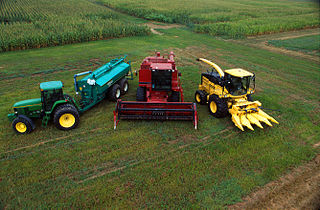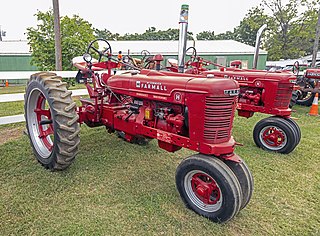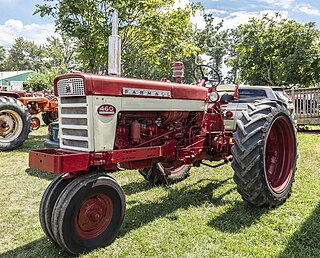
A threshing machine or a thresher is a piece of farm equipment that separates grain seed from the stalks and husks. It does so by beating the plant to make the seeds fall out. Before such machines were developed, threshing was done by hand with flails: such hand threshing was very laborious and time-consuming, taking about one-quarter of agricultural labour by the 18th century. Mechanization of this process removed a substantial amount of drudgery from farm labour. The first threshing machine was invented circa 1786 by the Scottish engineer Andrew Meikle, and the subsequent adoption of such machines was one of the earlier examples of the mechanization of agriculture. During the 19th century, threshers and mechanical reapers and reaper-binders gradually became widespread and made grain production much less laborious.

The modern combine harvester, or simply combine, is a machine designed to harvest a variety of grain crops. The name derives from its combining four separate harvesting operations—reaping, threshing, gathering, and winnowing—to a single process. Among the crops harvested with a combine are wheat, rice, oats, rye, barley, corn (maize), sorghum, millet, soybeans, flax (linseed), sunflowers and rapeseed. The separated straw, left lying on the field, comprises the stems and any remaining leaves of the crop with limited nutrients left in it: the straw is then either chopped, spread on the field and ploughed back in or baled for bedding and limited-feed for livestock.

The International Harvester Company was an American manufacturer of agricultural and construction equipment, automobiles, commercial trucks, lawn and garden products, household equipment, and more. It was formed from the 1902 merger of McCormick Harvesting Machine Company and Deering Harvester Company and three smaller manufacturers: Milwaukee; Plano; and Warder, Bushnell, and Glessner. Its brands included McCormick, Deering, and later McCormick-Deering, as well as International. Along with the Farmall and Cub Cadet tractors, International was also known for the Scout and Travelall vehicle nameplates. In the 1980s all divisions were sold off except for International Trucks, which changed its parent company name to Navistar International.

The International Harvester Scout is an off-road vehicle produced by International Harvester from 1960 to 1980. A precursor of more sophisticated SUVs to come, it was created as a competitor to the Jeep, and it initially featured a fold-down windshield. The Scout and second-generation Scout II were produced in Fort Wayne, Indiana as two-door trucks with removable hard tops, with options of a full-length roof, half-cab pickup, and/or soft top.
Case IH is an American agricultural machinery manufacturer. It was created in 1985 when Tenneco bought selected assets of the agricultural division from International Harvester and merged it into its J.I. Case Company. Today Case IH is owned by CNH Industrial, an American-Italian corporation.

Case Construction Equipment is an Italian manufacturer of construction machinery. Along with CASE IH, Case Construction Equipment is a brand of CNH. Case produces construction equipment including excavators, motor graders, wheel loaders, vibratory compaction rollers, crawler dozers, skid steers, and compact track loaders.

The Case Corporation was a manufacturer of agricultural machinery and construction equipment. Founded, in 1842, by Jerome Increase Case as the J. I. Case Threshing Machine Company, it operated under that name for most of a century. For another 66 years it was the J. I. Case Company, and was often called simply Case. In the late 19th century, Case was one of America's largest builders of steam engines, producing self-propelled portable engines, traction engines and steam tractors. It was a major producer of threshing machines and other harvesting equipment. The company also produced various machinery for the U.S. military. In the 20th century, Case was among the ten largest builders of farm tractors for many years. In the 1950s its construction equipment line became its primary focus, with agricultural business second.
New Holland is a global full-line agricultural machinery manufacturer founded in New Holland, Pennsylvania, and now based in Turin, Italy. New Holland's products include tractors, combine harvesters, balers, forage harvesters, self-propelled sprayers, haying tools, seeding equipment, hobby tractors, utility vehicles and implements, and grape harvesters. Originally formed as the New Holland Machine Company in 1895, the company is now owned by CNH Industrial N.V., a company incorporated in the Netherlands.

Daniel Best was an American adventurer, businessman, farmer, and inventor known for pioneering agriculture machinery and heavy machinery.

The International L series was introduced by International Harvester in fall 1949 as the replacement for the KB series and were available as everything from light pickup trucks and delivery vehicles to full-size tractor-trailers. Electric wipers, a radio, and a clock were optional. International would continue to produce the line until 1953 when it was replaced by the R series.
Laverda is a manufacturer of combine harvesters and hay equipment, based in Breganze, Italy. It was founded in 1873 by Pietro Laverda to produce farming implements in the Province of Vicenza. 1956 was the year the first self-propelled Laverda combine, the M 60, was manufactured. Laverda formed a partnership with Fiat in 1981, and would be a part of that company for some 20 years.
The Gleaner Manufacturing Company is an American manufacturer of combine harvesters. Gleaner has been a popular brand of combine harvester particularly in the Midwestern United States for many decades, first as an independent firm, and later as a division of Allis-Chalmers. The Gleaner brand continues today under the ownership of AGCO.

Agricultural machinery relates to the mechanical structures and devices used in farming or other agriculture. There are many types of such equipment, from hand tools and power tools to tractors and the countless kinds of farm implements that they tow or operate. Diverse arrays of equipment are used in both organic and nonorganic farming. Especially since the advent of mechanised agriculture, agricultural machinery is an indispensable part of how the world is fed. Agricultural machinery can be regarded as part of wider agricultural automation technologies, which includes the more advanced digital equipment and robotics. While agricultural robots have the potential to automate the three key steps involved in any agricultural operation, conventional motorized machinery is used principally to automate only the performing step where diagnosis and decision-making are conducted by humans based on observations and experience.

Claas Lexion is a series of combine harvesters, manufactured by Claas in Harsewinkel. An American version called Lexion was produced by Claas Omaha Inc. in the United States.

CNH Industrial N.V. is an Italian-American multinational corporation with global headquarters in Basildon, United Kingdom, but controlled and mostly owned by the multinational investment company Exor, which in turn is controlled by the Agnelli family. The company is listed on the New York Stock Exchange. The company is incorporated in the Netherlands. The seat of the company is in Amsterdam, Netherlands, with a principal office in London, England.

The agricultural machinery industry or agricultural engineering industry is the part of the industry, that produces and maintain tractors, agricultural machinery and agricultural implements used in farming or other agriculture. This branch is considered to be part of the machinery industry.

The Farmall H is a medium-sized two-plow row crop tractor produced by International Harvester under the Farmall brand from 1939 to 1954. It was the most widely produced of International Harvester's "letter series", with approximately 390,000 produced over the 14-year run. It succeeded the Farmall F-20. The H was incrementally updated with new model numbers as the Super H, 300, and 350, but remained essentially the same machine. The original H used an International Harvester C152 4-cylinder in-line engine. Production of all versions lasted until 1963.

The Farmall A is a small one-plow row crop tractor produced by International Harvester under the Farmall brand from 1939 to 1947. The tractor was popular for its set of innovative features in a small, affordable implement. It succeeded the Farmall F-14. The A was incrementally updated with new model numbers as the Super A, 100, 130 and 140, but remained essentially the same machine. Like the smaller Farmall Cub, the Farmall A features a distinctive offset engine, displaced to the left over wide-set front wheels, to allow vision straight ahead. An International Harvester C113 4-cylinder in-line engine was used for early models, increased to an IH C123 with the A-1. The most significant change was the introduction of hydraulics with the Super A. The series was produced until 1973.

The Farmall 60 series tractors are general-purpose row-crop tractors that replaced the larger models of the Farmall letter series beginning in 1958. Produced from 1958 to 1963, the Farmall 460 and 560 tractors represented a modernization of the Farmall H and Farmall M respectively, with higher-horsepower 6-cylinder engines in a restyled body. The heavy general-purpose 660 was sold under the International brand, and was a successor to the McCormick-Deering W series tractors.















